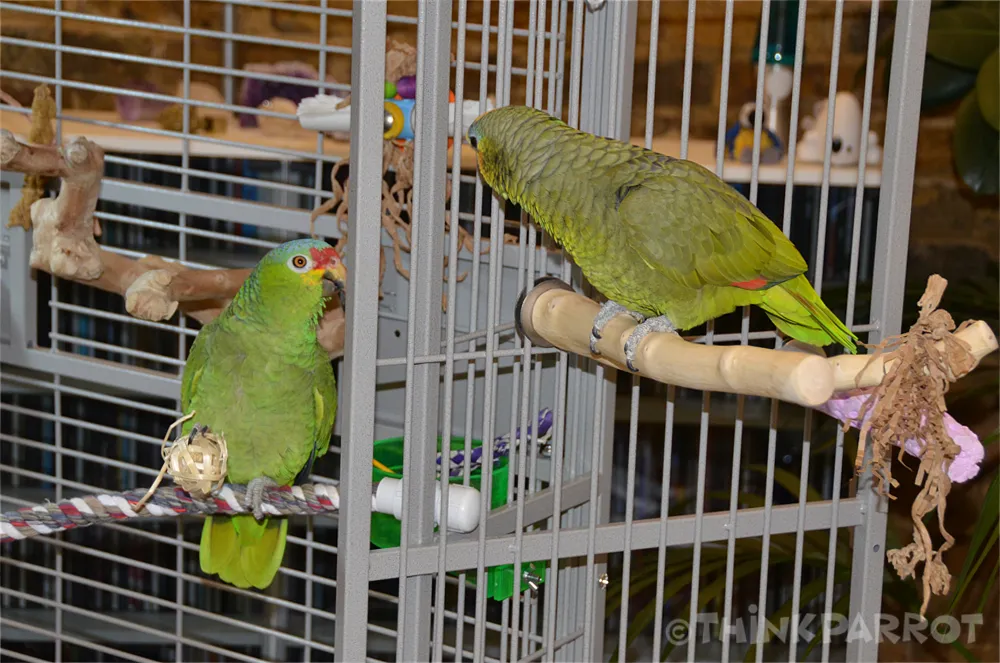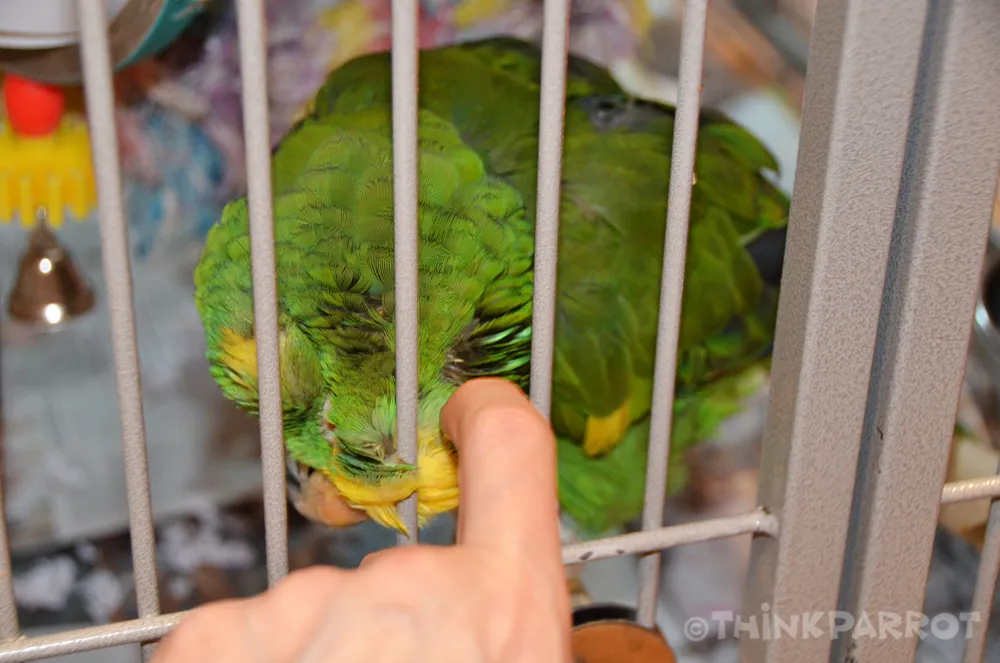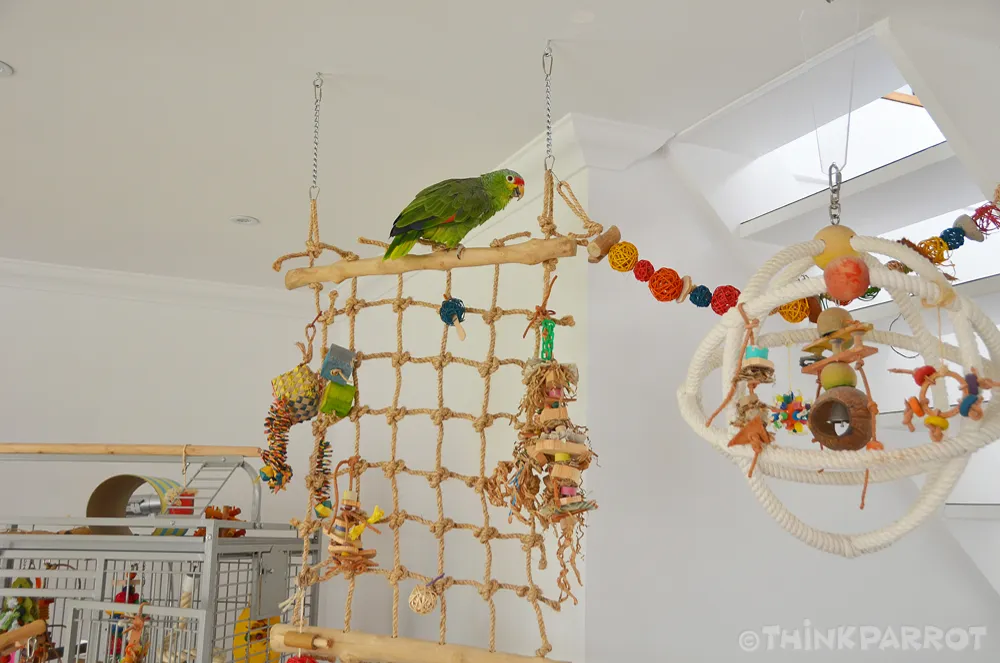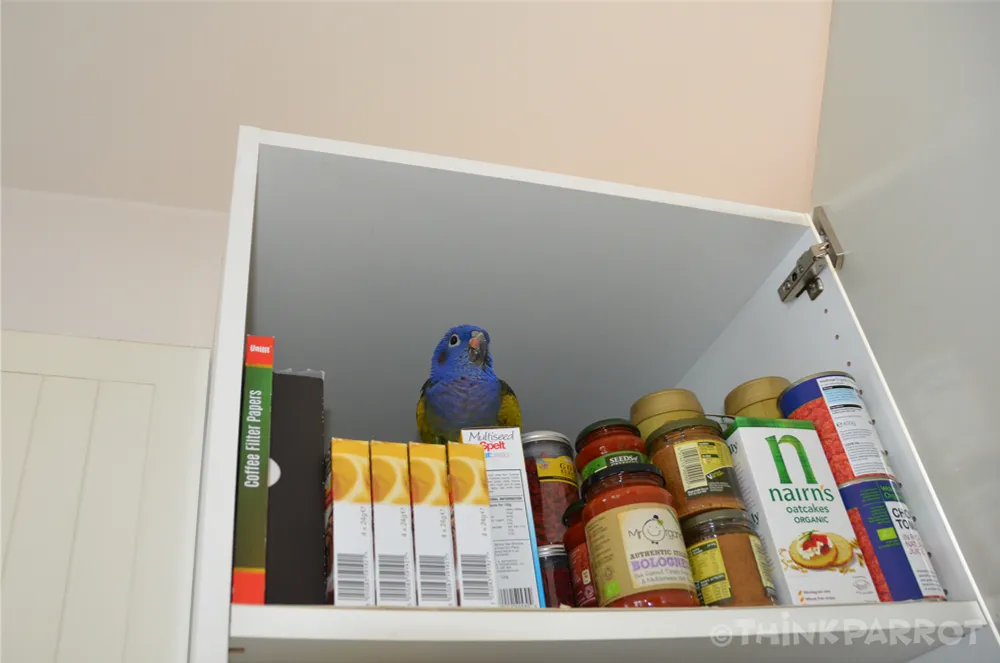Parrots, despite their vibrant colors and playful personalities, can sometimes exhibit aggressive behaviour, a challenge many parrot owners face. While rarely seen in the wild without cause, aggression in captive parrots is often a defense mechanism to protect perceived resources such as a nest site, territory, food, or a mate. In their natural habitat, body language and vocalizations are typically sufficient to deter intruders, and the vast space allows them to flee from danger. However, in a home environment, with limited space, a cage, or clipped wings, a parrot’s ability to escape is severely restricted. In such scenarios, displaying “aggressive” behaviour or biting often becomes their only recourse for self-defense. Understanding the nuances of parrot aggression, therefore, requires a sensitive and informed approach from human caretakers.
The term “aggressive” is often a human construct, a label we apply to a bird’s observable actions. A parrot’s behaviour might be interpreted as fearful, excited, or a complex mix of emotions. Rather than fixating on labels, focusing on the observable behaviours—like biting or the body language leading up to it—allows us to address the root causes more effectively. This article, developed by the “Dog Care Story” team, aims to provide comprehensive guidance for parrot owners in Vietnam and beyond, offering actionable strategies rooted in animal behavior science to mitigate and prevent Parrot Aggressive Behaviour, ensuring a harmonious living environment for both parrots and their human companions.
Deciphering Parrot Body Language
Parrots are incredibly adept at communicating through their body language, a skill essential for their survival in the wild. They are constantly aware of our body language, processing subtle cues that we often overlook in their own communication. By learning to read their signals, we can often de-escalate unwanted behaviour before it turns into full-blown aggression. If we consistently ignore a parrot’s warnings, they may eventually stop giving them, leading to bites that appear to “come out of nowhere.”
Changes in body language can be subtle, almost imperceptible, but they are almost always present. You might observe a parrot breathing a little heavier, gripping its perch tighter, or its eyes widening slightly (known as “pinning”). Its head might pull back, or its entire body might lean away. A quick darting of the eyes, looking for an escape route, is another common sign. The way a parrot holds its feathers can also be a significant indicator; they might rise or flatten depending on the individual and the context. For instance, the bare skin on a Macaw’s face might flush pink. Some parrots may repeatedly open their beaks wide, a behaviour often called gaping, signaling discomfort. More overt signs include standing tall with feathers raised, tail fanned out, or crouching forward with an open beak. These behaviours, whether attributed to aggression, excitement, or fear, fundamentally communicate “I’m not comfortable” or “back off!”
For example, with a Blue-headed Pionus parrot like Kobe, a tell-tale sign of discomfort is the rising of feathers on his head and upper shoulders. Recognizing this cue allows caretakers to immediately back off and avoid direct eye contact, which can often exacerbate the situation. Learning to respond to these early warnings, perhaps by offering a soothing vocalization or simply creating space, can effectively diffuse potential conflicts and reinforce trust.
 Two parrots, Bobbie and Ollie, interacting on a perch, with one displaying warning signs of aggression towards the other.
Two parrots, Bobbie and Ollie, interacting on a perch, with one displaying warning signs of aggression towards the other.
Preventing Aggressive Behaviour by Modifying Antecedents
The most effective way to address parrot aggressive behaviour is to prevent it from happening in the first place. This involves understanding the antecedents—the events or situations that immediately precede the unwanted response—and modifying them. By changing our own behaviour and the environment, we teach the bird that aggressive responses are not necessary. If we continue with the same actions, we inadvertently reinforce the parrot’s aggressive tendencies.
Consider a scenario where a parrot exhibits aggressive body language, such as biting at cage bars or lunging, when you approach its cage. A simple solution might be to reposition the cage to an area where people don’t have to walk directly towards or beside it. Sometimes, approaching an occupied cage or playgym in a zigzag pattern, pretending to go elsewhere, can reduce perceived threat.
If the challenge lies in cleaning the cage, it’s often best to remove the bird first. If this isn’t feasible, move slowly and deliberately to avoid reinforcing any chasing or biting at your hands. Training the parrot to “target” or “station” on a perch in another part of the cage can be incredibly effective. This strategy has been successfully used to manage extremely aggressive responses in disabled parrots, turning potentially confrontational situations into opportunities for positive interaction and trust-building. Pairing your presence with positive experiences, such as gentle singing or rewarding desired behaviours, can significantly transform a parrot’s perception of interactions.
 A Panama Amazon parrot named Chico calmly receiving a head scratch while stationing on a perch, demonstrating positive reinforcement for peaceful interaction.
A Panama Amazon parrot named Chico calmly receiving a head scratch while stationing on a perch, demonstrating positive reinforcement for peaceful interaction.
It is crucial to avoid over-exciting your parrot during playtime, as excessive stimulation can quickly tip over into aggression or biting. If you notice signs of over-excitement, immediately pause play or freeze for a few seconds to allow the bird to calm down.
Resource guarding is another common issue, where a parrot might attack a hand that comes too close to its food bowl, a favorite toy, or a nesting site. Teaching a bird to station on a perch at the opposite end of its cage for a high-value treat allows you to safely manage resources. Similarly, if a parrot shows a tendency to attack feet, ensure everyone wears slippers or shoes. Better yet, encourage the bird to spend time on its own “furniture,” such as play stands or hanging boings, filled with enriching activities and foraging opportunities, rather than on the floor. Gradual desensitization can also work wonders, as demonstrated by successfully training a Red-lored Amazon parrot to tolerate feet after initially biting them.
Addressing perceived nesting sites is also vital. If a bird defends specific areas, such as a room or small dark spaces, remove access to these locations. Close off gaps, remove boxes, and prevent access to cupboards. By making alternative areas like playstands more enriching, the parrot will be more inclined to explore these instead. For visitors, caging the bird for the duration of the visit can prevent unwanted behaviour and protect both the bird and guests. It’s important for the owner to advocate for their bird, ensuring visitors understand not to approach the cage if it causes discomfort. Maintaining calm energy levels during interactions also contributes to a more relaxed environment for the parrot.
All these solutions share a common thread: they are antecedent changes that occur before the aggressive behaviour. Antecedents cue or set the stage for behaviour. Once a bird has bitten or attacked, it’s too late to intervene in that specific instance. Punishment, far from being a solution, is counterproductive and can exacerbate the problem.
The Ineffectiveness of Punishment
Punishment, whether in the form of yelling, hitting, or even ignoring a bite, is generally ineffective in addressing parrot aggressive behaviour in the long term. Firstly, it doesn’t teach the bird what to do instead of the unwanted behaviour. Secondly, punishment often escalates, leading to more severe measures as the initial deterrent loses its effect. Most importantly, punishment has significant negative consequences, including increasing aggression (the very behaviour you’re trying to stop), apathy, and fear, which can even develop into phobias.
Moreover, using aversives creates a negative association between you and the unpleasant experience. This means that you, as the caretaker, become linked with the punishment, inevitably eroding the trust you’ve built with your bird. A parrot that fears its owner is less likely to engage in positive interactions and more likely to exhibit stress-related behaviours, including heightened aggression. Instead of resorting to punishment, more effective and humane methods focus on changing the environment and teaching alternative, acceptable behaviours.
Negative Reinforcement and Constructional Aggression Treatment (CAT)
While positive reinforcement is often the go-to method for behaviour modification, negative reinforcement and specifically Constructional Aggression Treatment (CAT) can be powerful tools for addressing extreme fear or aggressive responses, especially when desensitization and counter-conditioning alone are insufficient. CAT is a specialized procedure that requires a skilled trainer due to its precise timing and ability to read subtle body language cues.
The first step in applying CAT is to identify what the parrot gains from its aggressive (or fearful) behaviour. If the bird’s goal is to make you move away, CAT might be an appropriate strategy. CAT is founded on the principles of negative reinforcement, where a desired behaviour is reinforced by removing an aversive stimulus—which is exactly what the parrot wants. This aversive stimulus is often a human, but it could also be an object the bird fears.
CAT: The Shaping Procedure
The CAT shaping procedure involves starting at a distance from the parrot where its body language remains relaxed.
- Initial Approach: Take one or two steps towards the bird until you observe the very beginnings of uncomfortable body language. This could be subtle signs like slightly heavier breathing, widening eyes, or a minor change in feather posture. It’s crucial not to advance beyond this mild response.
- Reinforcement by Retreat: Stand at this sub-threshold distance until the bird begins to relax and offers alternative behaviours, such as turning its head, shifting its weight, preening, or rousing its feathers. Immediately reinforce these desired actions by turning around and walking back to your starting point, thereby removing the aversive stimulus (your presence).
- Repeat and Progress: Repeat this approximation at the same distance until the bird consistently remains relaxed. Then, move to the next approximation by slightly decreasing the distance between you, always ensuring that the bird experiences only the lowest level of discomfort. Again, wait for an alternative desired behaviour and immediately reinforce by retreating.
- Gradual Closeness: Continue this process, gradually getting closer to the bird in small, manageable steps. Training sessions should be kept short, perhaps 5 to 10 minutes, to minimize stress. The goal is for the bird to feel comfortable enough to move around at your approach rather than freezing.
With correct application, there will come a point where the bird consistently offers relaxed body language at your approach. At this stage, you can gently transition to positive reinforcement, using favorite treats to reward its calm demeanor. Although CAT is a powerful technique, its complexity means working with a qualified behaviorist experienced in CAT is often recommended to avoid inadvertently worsening the situation.
Enhancing Your Parrot’s Environment and Repertoire of Behaviours
Beyond addressing specific aggressive responses, a proactive approach involves enriching your parrot’s environment and expanding its repertoire of acceptable behaviours. By providing engaging activities and consistent training, you can foster a happier, more balanced bird with less inclination towards unwanted behaviours.
Increase the Bird’s Repertoire of Behaviours
The more behaviours your parrot knows, the more choices you have to cue in various situations. This reduces reliance on aggressive responses by giving the bird other ways to communicate and interact.
Training as a Positive Tool
Training is an invaluable tool for both modifying existing behaviours and building a stronger bond with your parrot. Teaching new behaviours is inherently reinforcing for both bird and owner. Start with something simple and highly rewarding, such as “targeting.” Targeting involves teaching the parrot to touch an object (like the end of a chopstick) with a specific body part (beak or foot) for a reinforcer, typically a favorite treat. This can be practiced both inside and outside the cage.
 A parrot named Ollie engaging in target training by touching the end of a chopstick with its beak, an effective positive reinforcement technique.
A parrot named Ollie engaging in target training by touching the end of a chopstick with its beak, an effective positive reinforcement technique.
When shaping any new behaviour, ample opportunities for reinforcement abound. Because you are the one consistently providing these positive experiences, the bird will begin to associate your presence with rewarding outcomes, fostering a positive relationship. Involving all family members in target training ensures that everyone can provide positive reinforcement, creating a consistently good experience for the parrot.
Keeping Your Parrot Occupied
A busy parrot is a happy parrot, and a happy parrot has less time and fewer reasons to engage in aggressive behaviours. Consider what your bird can be doing while you are engaged in other activities like watching TV, working on the computer, or cooking dinner. Provide stimulating “furniture” like a large spring swing hanging from the ceiling, or a play stand on wheels with a variety of favorite toys.
Foraging opportunities are particularly beneficial, tapping into a parrot’s natural instincts. By making their environment consistently interesting and mentally stimulating, you reduce boredom and redirect their energy into constructive activities. Many perceived instances of “hormonal aggression” are often linked to a lack of enrichment and opportunities for success. Providing consistent positive reinforcement for desired behaviours, even simple ones like going into a night cage, can significantly reduce aggressive displays.
 A parrot, Bobbie, actively playing and foraging on a cargo net in an enriched environment, demonstrating the benefits of mental stimulation.
A parrot, Bobbie, actively playing and foraging on a cargo net in an enriched environment, demonstrating the benefits of mental stimulation.
Addressing Hormonal Influences
While aggression is often attributed to hormones, it’s important to remember that the rules of behaviour (cause and effect) still apply. Hormonal surges can certainly make a parrot more sensitive to environmental cues and cause-and-effect relationships. Combine this sensitivity with access to perceived nesting sites or unhealthy pair bonding with one human, and you can create a challenging situation where the bird attempts to drive away other family members.
Strategies to Mitigate Hormonal Aggression
- Discourage Unhealthy Pair Bonding: Be a good friend to your parrot, encouraging independent play and interaction rather than constant physical contact. Avoid stroking your bird anywhere other than its head and possibly neck, and keep these interactions brief. While baby parrots might tolerate extensive cuddling, this changes as they mature and seek independence. Overly tactile interactions can be misinterpreted as mating cues, leading to possessiveness and aggression towards others.
- Encourage Healthy Interactions from All Family Members: All family members should engage with the parrot through positive reinforcement training. Parrots will naturally choose to interact with individuals who provide rewarding consequences. If a family member is being targeted, using CAT (Constructional Aggression Treatment) as previously described can be highly effective. Once that person can approach the cage with the bird displaying relaxed body language, they can transition to target training through protective contact (e.g., through the cage bars). This builds confidence in the human and reinforces positive interactions. Simultaneously, the “favored” person must reduce pair-bond behaviours like extensive cuddling and shoulder time, shifting to a training-based relationship.
- Remove Perceived Nest Sites: Boxes, access to small dark places (drawers, cupboards, gaps under furniture), playing with the bird under blankets, or allowing it inside your shirt can all be perceived as nesting sites. Eliminate access to these areas to reduce hormonal triggers.
 A parrot, Kobe, inside a cupboard, displaying body language that warns against approaching, indicating resource guarding behavior within a perceived nesting site.
A parrot, Kobe, inside a cupboard, displaying body language that warns against approaching, indicating resource guarding behavior within a perceived nesting site. - Ensure Adequate Exercise: Physical activity, especially flying, helps parrots expend pent-up energy and releases “feel-good” endorphins. Regular exercise also supports muscular and bone health, preventing long-term physical issues like arthrosclerosis and osteoporosis.
- Review Diet: Avoid warm, mushy foods and excessive carbohydrates or fats, as these can sometimes contribute to hormonal fluctuations. Consult with an avian veterinarian for appropriate dietary recommendations.
- Prioritize Sleep: Ensure your parrot gets plenty of undisturbed sleep. If your bird is in a room with constant activity or artificial light at night, it won’t get proper rest, potentially leading to a “grouchy” demeanor. Consider moving its cage to a quiet, dark room or using a dedicated night cage. However, be aware that some birds may perceive a small night cage as a nesting site; if the bird is reluctant to leave it, it’s better to let it sleep in its main cage.
What to Do If Your Parrot Bites or Attacks
While the primary goal is prevention, bites can still happen. The common advice to “ignore the bite” is often misguided. Ignoring a bite can signal to the bird that its attempt at communication has been unheard, leading to a feeling of powerlessness over its environment. This can result in learned helplessness and a breakdown of trust, often prompting the bird to bite harder and more savagely to make itself understood.
Instead, acknowledge the bite by showing that it hurts, but avoid an over-the-top reaction, as this can inadvertently become a “drama reward” for the bird. Try your best to de-escalate the situation and remove any reinforcement. If the bird is on you, calmly put it down. If its body language still indicates agitation, simply walk away. In the case of a flying attack, remove any reinforcement by ducking and walking away from the situation. The key is to convey that biting does not achieve its desired outcome, without instilling fear or breaking trust.
In a Nutshell
Managing parrot aggressive behaviour is an ongoing journey that requires patience, observation, and a commitment to understanding your bird’s unique needs. The most effective strategy is to identify and address potential issues as early as possible. This involves proactively arranging the environment to minimize triggers for aggression and consistently reading and heeding your parrot’s body language. By adjusting antecedents—the situations preceding unwanted behaviour—you can prevent many aggressive displays before they even begin.
Continuously pair your presence with positive experiences for your parrot, such as offering engaging training sessions where they can earn reinforcers. Highly reinforce any acceptable behaviours while being careful not to inadvertently reward aggressive responses. Providing an enriched environment with ample toys, foraging opportunities, and mental stimulation is crucial; a busy, engaged bird has less time and fewer reasons to engage in unwanted behaviours. By focusing on positive reinforcement, clear communication, and a deep understanding of avian behaviour, you can foster a trusting and harmonious relationship with your feathered companion.
Resources
- Steve Martin’s Understanding Behavior, Naturally: https://naturalencounters.com/wp-content/uploads/2020/04/Understanding_Parrot_Behavior_Naturally-Steve_Martin.pdf
- Dr Susan Friedman’s Alternatives to Breaking Parrots: Reducing Aggression and Fear through Learning, 2002: https://www.behaviorworks.org/files/articles/Alternatives%20to%20Parrot%20Breaking%202002.pdf
- Pamela Clark’s Avoiding Aggression with Start Buttons: https://blogpamelaclarkonline.com/2019/01/31/parrot-and-start-buttons/
- Barbara Heidenreich’s Addressing Aggressive Behavior in Birds: https://journals.tdl.org/watchbird/index.php/watchbird/article/download/1869/1842
- Mario Ancic’s explanation of Constructional Aggression Treatment (CAT): https://www.training-your-dog-and-you.com/constructional_aggression_treatment.html
- Barbara Heidenreich’s podcast interview on CAT with Kellie Snider: https://animaltrainingfundamentals.com/podcasts/c-a-t-with-kellie-snider/
- Barbara Heidenreich’s podcast interview on CAT with Jesus Rosales-Ruiz and Mary Hunter: https://animaltrainingfundamentals.com/podcasts/effective-reinforcement-with-jesus-rosales-ruiz-and-mary-hunter/

 A parrot, Kobe, inside a cupboard, displaying body language that warns against approaching, indicating resource guarding behavior within a perceived nesting site.
A parrot, Kobe, inside a cupboard, displaying body language that warns against approaching, indicating resource guarding behavior within a perceived nesting site.